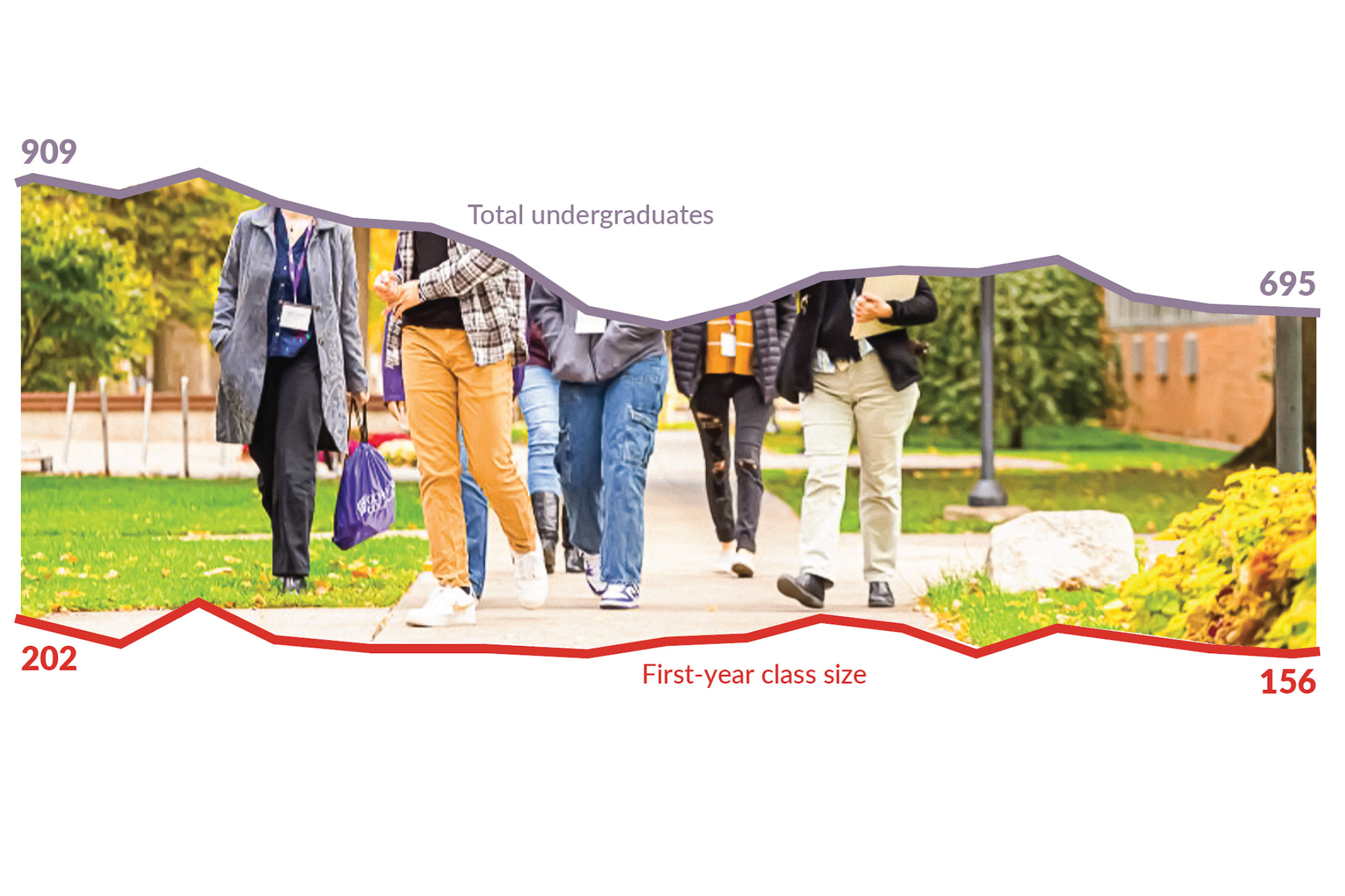With 695 students in traditional undergraduate programs and a freshmen class of 156 students, President Rebecca Stoltzfus is “dissatisfied” with enrollment numbers. The freshmen cohort is the lowest since 2002, according to the registrar’s office.
Stoltzfus said, though, that “there’s nothing we’re focused on more than increasing undergraduate enrollment” and that some “early signs are looking up.”Steve Wolma, vice president for enrollment management, characterized the decline in students as a “dip, not a trend.” Wolma described how multiple factors were at play for last year’s dip: “a very thin year staff-wise … combined with a growing concern that college might not be worth the money among graduating high school seniors and their families.”
While national college perceptions aren’t very controllable, staffing in admissions is. This year, the admissions department has a full staff, after multiple years of vacancies. Wolma said, “We’ve addressed the understaffing problem. We can control that.”
Due to what Stoltzfus described as “pandemic burnout,” turnover in the department was high. She said that last year, Wolma “was essentially doing three jobs” in the enrollment department, along with admissions counselor positions going unfilled.
The declining student body has hit the humanities especially hard. According to the Goshen College fact book, last year, nine students on campus were majoring in art; 15 years earlier, 66 were. In that same span, the number of students majoring in English has shrunk from 38 to 9; history from 42 to 23; music from 56 to 24; Spanish from 29 to 4; theater from 29 to 9; Bible and religion from 39 to none. Other humanities majors at GC include writing and peace, justice and conflict studies.
Again, multiple factors are at play. Some of this is due to GC’s decline of over 200 undergraduate students in those 15 years, so most majors have seen drops (only accounting, broadcasting, computer science and molecular biology have seen the number of majors grow). Also, some adjacent majors have been added, like graphic design and criminal justice, which could siphon away from art and history, respectively.
But a lot of it is part of a “30-year trend of a revolt in the humanities,” according to Stoltzfus.
Especially in the last 15 years, Stoltzfus said, national headlines have had an intense focus on a “return-on-investment by major,” which has “pummeled the humanities.” These economic-focused analyses are “an unfair burden for the humanities, but a reality” according to Stoltzfus: “Economic and cultural messages do some of the work for business and nursing majors, but it’s more essential that the arts and humanities repackage and re-articulate the value for careers.”
Jessica Baldanzi, professor of English and chair of the department, said she’s used to defending the value of an English major. “We should be able to justify it,” Baldanzi said, since “college is expensive. I’ve just gotten better at articulating” the value of “critical thinking … careful reading, writing and well-constructed questions that get to the root of things.
“I believe in what I do,” she said.
Philipp Gollner, associate professor of history, has noticed the effects of dwindling admissions in his department. He said that if GC has more admissions cycles like in past years, “it is an existential threat to the history major.” The admissions “boom-and-bust cycle is felt immediately,” he said, with consequences of students having fewer courses offered and faculty not teaching in their field of expertise.
Gollner said that he has heard from prospective students interested in the humanities who are “not sure whether Goshen is academically rigorous.” It’s a hard balance, he acknowledged: “You don’t want to put yourself out there and say, ‘we’re a tough place’ — that’s not how you market.” He said that students “expect to be courted,” though, and with an understaffed admissions department in recent years, he has noticed a “drain in prospective students between the stage of admitted and deposited … who go to another liberal arts college.”
Baldanzi has also noticed how national trends are affecting the English department, and especially with faculty. “We used to have seven professors [who weren’t all full-time],” she said, but after some left for a different position at GC or retirement, “we’d think we’d be able to do a search to replace them, but … they just never got replaced.” The department now has just two professors.
Small classes have been hard for Baldanzi, too: “It’s a struggle to keep our enrollment at the levels that the administration wants them at — we get pressure to cancel any class that is smaller than 10.”
When she repeatedly has small classes, “it’s exhausting to always have the value of what I teach questioned,” she said. “But on the other hand, we don’t want the college to go bankrupt supporting the humanities.”
As for the history major being existentially threatened, Stoltzfus said “it’s possible,” but noted that GC “is outperforming fourfold” the number of history majors out of 1,000 students, compared to the national average. “We can’t conjure students out of nothing,” she said. “Would faculty want more students? Yes. Do I want more? Yes. But we can’t ignore the cultural factors at work.”
Wolma said that the humanities at GC have declined 8% in their representation in the graduating class for the 10 most recent years of data available. Nationally, though, according to a similar dataset Wolma consulted, the decline for the humanities has been about 17%. “GC is not out of step with the national trends related to students in the humanities,” Wolma said. “If anything, we’re holding slightly better.”
For Scott Hochstetler, professor of music, recruiting students is a little different than it is for other humanities. Ideally, he said, recruiting for “music and sports shouldn’t be hard.” There are rosters of athletes and musicians, along with easy-to-contact coaches and choir directors — which isn’t true for potential students in the humanities.
He said that, anecdotally, he has noticed the understaffing in admissions. There were students he tried to recruit, but “they weren’t being pursued by anyone else in the college.” This year has been better, though — with the full staff, “it is running very smoothly now.”
Joey Paternostro had a smooth admissions experience last year — it’s not a stretch to say that without one text from a GC baseball coach, he wouldn’t be here. Paternostro, a freshman broadcasting major from northwest Indiana, was set on either going to Ball State for broadcasting or Purdue to be a pilot — “Goshen was not in the picture.” After he got an invitation from Coach Justin Grubbs, though, Paternostro came to “recruit day” last September.
Paternostro wanted to study broadcasting, so he was strongly considering Ball State. After visiting GC, though, he realized he could match his two passions of broadcasting and baseball. “I did some research … and realized that if I came to Goshen, everything that I wanted would outweigh other colleges.”
For Paternostro, “baseball is my life, my peanut butter and jelly, my second home” — and Goshen was the best place to play baseball and study broadcasting. Right away, he noticed that the department “is at the top of their game”: as he walked into the communication wing during his visit, “I saw the wall of awards, I thought, ‘OK, that’s all I really need to know.’”
And after his visit, he felt like a priority. He said his admissions counselor would “shoot back an answer” to any question he had, usually “within an hour.”
Hochstetler said that he hopes enrollment trends upward again, “for all of our sakes.” People in the humanities are often shared between departments — “recruiting more theater students is going to help the music program … the students that write often, they usually play and sing, too.” Hochstetler sees admissions as part of his job. Along with H. Roz Woll, assistant professor of music, they have invited over 260 high school students from nine high school choirs to sing in Sauder Hall alongside GC choirs this semester to get them on campus and sing in the space.
“Professors are ready to help,” Hochstetler said. “We’ll do the extra work. We are overworked … but the need for recruiting is absolutely essential.” He hopes for fewer stories of missed connections and “more stories of, ‘Oh my goodness, Goshen wouldn’t stop calling me, but they were so nice, and I had such a great visit, and I really feel wanted, and I think I’m going to go there.’”
As for the early admissions signs that are pointing up: Wolma said GC is “gaining traction” in the metrics from Elkhart County, a traditionally high-yield area. “Our applications and admits are up in general,” Wolma said, “but we’re really seeing it in the places where we tend to have higher yield … which makes us feel like we’re in a stronger position at this point than we were last cycle. … Having a full staff and increasing efforts in the local area are contributing to putting us in a much better position than we were last year.”
A correction was made on Nov. 20, 2023: In an earlier version of this article, we misstated a statistic, which may have inadvertently misled readers on the size of the English department. The number of students majoring in English has decreased from 38 to 9 in the 15-year span; the original article mistakenly attributed the decline to the English department as a whole, which includes the writing major.



